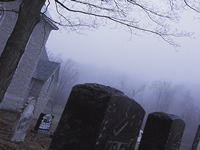Module 2: Section A
Sleepy Hollow, Part 1
Have you heard the one about the Headless Horseman? He chases the schoolteacher down the dark, spooky road over a rickety bridge to kill him by pelting him with his own head. Who doesn't love a good ghost story like this?
Washington Irving was an author who helped invent the American short story. All his stories were based on humorous and supernatural legends that the Puritans and others had suppressed and censored for being the work of the devil. Irving was a Romantic with a dark sense of humor. Let's experience part of his famous story "The Legend of Sleepy Hollow" to continue our exploration of rhetoric.
First, read and listen to part of the story. Keep an eye on how the author is using rhetoric to get his ideas across to you:

"An opening, in the trees now cheered [Ichabod Crane] with the hopes that the church bridge was at hand. The wavering reflection of a silver star in the bosom of the brook told him that he was not mistaken. He saw the walls of the church dimly glaring under the trees beyond. He recollected the place where Brom Bones' ghostly competitor had disappeard. "If I can but reach that bridge," thought Ichabod, "I am safe." Just then he heard the black steed panting and blowing close behind him; he even fancied that he felt his hot breath. Another convulsive kick in the ribs, and old Gunpowder sprang upon the bridge; he thundered over the resounding planks; he gained the opposite side; and now Ichabod cast a look behind to see if his pursuer should vanish, according to rule, in a flash of fire and brimstone. Just then he saw the goblin rising in his stirrups, and in the very act of hurling his head at him. Ichabod endeavored to dodge the horrible missile, but too late. It encountered his cranium with a tremendous crash, -he was tumbled headlong into the dust, and Gunpowder, the black steed, and the goblin rider, passed by like a whirlwind."
(Washington Irving, The Legend of Sleepy Hollow)
Now continue on to the next page to discover how rhetoric plays into the story's effectiveness.

